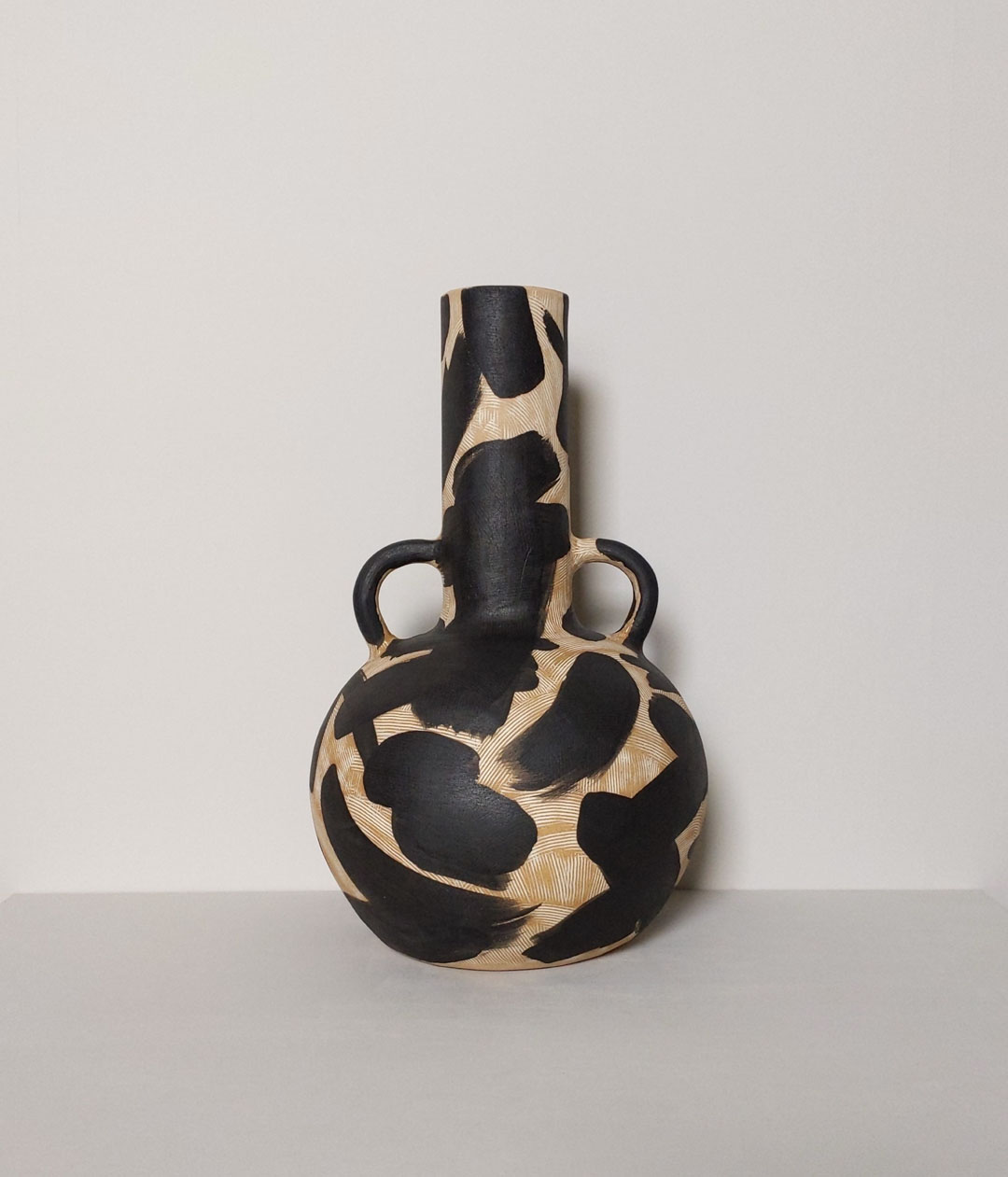Discover what lies behind the abstract patterns of Lydia’s colourful objects. And what she loves about getting her hands dirty.
Usually found in her Westcliff-on-Sea studio, with her sleeves rolled back and knuckle-deep in terracotta clay, Lydia Hardwick has been moulding and decorating ceramics for over 12 years. Don’t expect trendy floral-printed bowls and neutral vases. When she lifts the lid of her kiln, you’re more likely to find abstractly patterned pots and sculptural wall art, inspired by folk geometry as well as old-world craft objects and textiles.
Lydia’s work is all about layers of tones, textures, materials and colours, toeing the line between eye-catching artwork and functional home accessories. Think hand-coiled, earth-stained pots and striking decorative platters.
Since graduating from the Royal College of Art in 2013, Lydia has channelled her creative energy into private commissions and collaborations with galleries and retailers, including Notting Hill favourites Couverture & The Garbstore and the Alveston Fine Art Gallery. Most notably, her clay work was showcased at the design museum’s Designs of the Year and The Turner Prize exhibition. Spot her work among the V&A Museum’s permanent collection, too.
As both a ceramicist and an art teacher, Lydia’s schedule can get busy. Alongside fashioning clay, she has undertaken educational projects with the Royal Academy of Arts, Whitechapel Gallery, Camden Arts Centre and the Turner Contemporary.
In between firing up her kiln and her travels around the country, Lydia took a minute to speak to us about what drew her to ceramics and how she approaches her work.



Can you tell us about your background and how you fell in love with ceramics? What made clay stand out to you?
Halfway through studying for an undergraduate degree in sculpture, I switched to the ceramics department. I didn’t realise it at the time, but I needed my work to begin with a focus on material properties. The thing that sets ceramics apart from many other mediums is the chemical reaction that happens during a firing. It is this element of alchemy that keeps me using clay.
What is your creative process and how has it evolved?
Working with clay requires an equal balance of instinct and technical understanding. In this sense, it is simultaneously one of the easiest and most difficult materials to work with. Having used clay for over a decade, what still surprises me is how much of the making process comes not from conscious thought but from a different sort of knowing – like a sort of touch memory. Using surface techniques, such as inlaying and slip decorating, my working methods are meditative and intuitive.


How would you describe your work?
Hand-built, inlaid, slip decorated, patterned.
Materiality, colour and abstract motifs are intrinsic to your work. How do you decide these?
I’m often inspired by objects made by communities that attribute great expressive power to visual things. There can sometimes be a certain quality to the way a material has been processed, or a gestural mark has been made, that suggests something more than mere decoration. Pattern can hold significant meaning at the most fundamental human level, or even be a form of almost-language. I don’t replicate patterns that I research. Rather, I let patterns emerge from somewhere deep in my mind, where I’ve collected impressions of things that I have seen.


You’ve been very busy crafting amazing slip-decorated pots! What’s the inspiration behind these?
My work mixes a myriad of making traditions with influences from European art and design. In my slip-decorated pieces, I aim to make work that connects us to an ancient appreciation of line, surface, tone and texture.
What’s next for you?
I tend to think about life in terms of consistently making small, good adjustments based on my feelings at that moment, rather than aiming for big goals or projects. When I get work out of the kiln, I look very hard at it and make my next plan based on what I see. I suppose I am driven by the little things. Over the next year, I have plans to work with some interesting people and spaces… more to be revealed soon.
Proving that ceramics is where concept meets function, Lydia’s ceramics are as versatile as they are impressive. Swing by Notting Hill’s Alveston Fine Art Gallery or Couveture and the Garbstore and bring home pieces that are sure to add character to your space. Can’t find what you’re looking for? Get in touch with Lydia for a bespoke creation.




